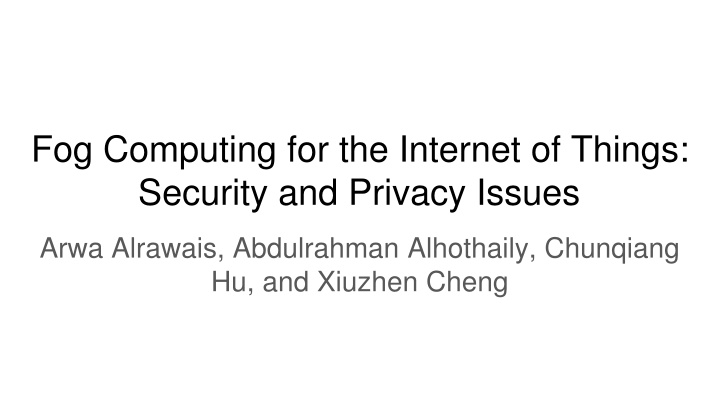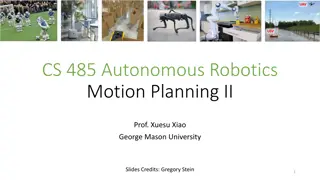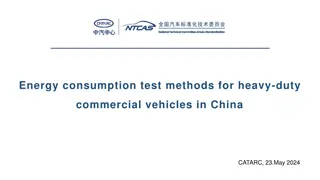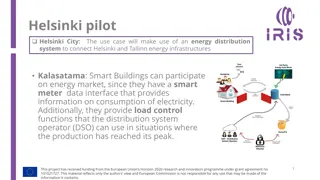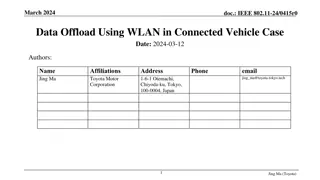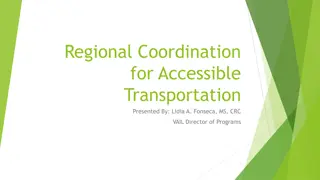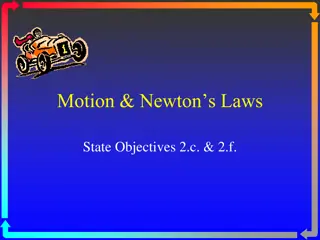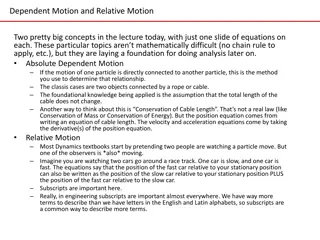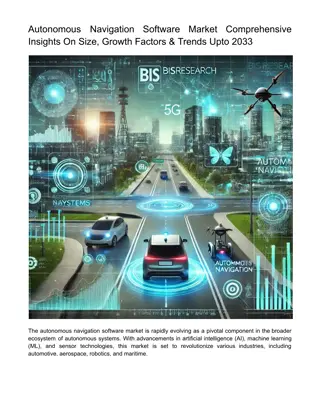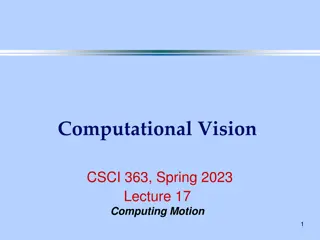Motion Planning for Autonomous Vehicles in Futuristic Transportation Systems
Motion planning for multiple autonomous vehicles is essential for creating a seamless and integrated futuristic transportation system. This involves problem-solving in mobile robotics, trajectory generation, and utilizing techniques like genetic algorithms, fuzzy logic, and reactive planning. The intelligent management of the transportation system focuses on routing objectives, traffic behavior experiments, dynamic traffic management, congestion avoidance, and maximizing on-time arrivals. The research aims to optimize traffic flow, reduce congestion, and enhance overall transportation efficiency.
Download Presentation

Please find below an Image/Link to download the presentation.
The content on the website is provided AS IS for your information and personal use only. It may not be sold, licensed, or shared on other websites without obtaining consent from the author.If you encounter any issues during the download, it is possible that the publisher has removed the file from their server.
You are allowed to download the files provided on this website for personal or commercial use, subject to the condition that they are used lawfully. All files are the property of their respective owners.
The content on the website is provided AS IS for your information and personal use only. It may not be sold, licensed, or shared on other websites without obtaining consent from the author.
E N D
Presentation Transcript
Fog Computing for the Internet of Things: Security and Privacy Issues Arwa Alrawais, Abdulrahman Alhothaily, Chunqiang Hu, and Xiuzhen Cheng
Introduction The goal of Fog computing is to reduce data volume and traffic to cloud, decrease latency and improve quality of service (QoS). Fog introduces new security and privacy challenges due to its distinct characteristics such as mobility support. On the other hand, Fog nodes can be represented as proxies that provide cryptographic computation which can help minimize attacks in IoT environments.
Security and Privacy Challenges in IoT Authentication: IoT devices don t have enough computation power to execute the cryptographic operation required for authentication. Trust: There are no efficient mechanism that can measure when & how to trust IoT device. Rogue node detection: A rogue IoT node can misuse user s data or disrupt neighboring nodes. Privacy: lack of encryption ability, location privacy, user s usage pattern Access Control: managing huge number of things & highly distributed data is challenged. Intrusion Detection: Its hard to detect insider and outsider attack in universal platforms. Data Protection: Data integrity must be preserved before and after processing
Case study: Resorting to Fog for Certificate Revocation in the IoT Two certificate revocation schemes: Certificate Revocation List (CRL) & Online Certificate Status Protocol(OCSP) CRL is a list maintains all revoked certificate serial numbers that should no longer be trusted. Certificate Authority (CA) releases its CRL with long window could lead to security issue such as accepting a revoked certificate. CRL file size grows over time and consumes clients storage.
Case study: Resorting to Fog for Certificate Revocation in the IoT OCSP is used to obtain digital certificate status online. A client submit request containing serial number that needs to be checked to OCSP responder server, and it checks its up-to-date revocation list and respond to the client the status of the certificate. OCSP overcome many drawbacks in CRL, such as: Doesn t require large storage at client OCSP s message is small compared to CRL OCSP provides immediate update about certificate status OCSP has some drawbacks, such as high latency and may impairs clients privacy
Case study: Resorting to Fog for Certificate Revocation in the IoT When it comes to IoT environment, the 2 schemes above are unsuitable. For CRL,it imposes high burden of communication overhead and required large storage on resources-limited IoT device. For OCSP, IoT device cannot afford to communicate each time OCSP server due to resource constraints. This paper proposes a scheme that uses fog node to improve efficiency of certificate revocation distribution in IoT environments.
Proposed Scheme They use bloom filter to create a short list that reduce the revocation list size A bloom filter is a space- efficient data structure to check whether an element is in the group.
Proposed Scheme Cloud manages multiple CA s revocation list and send to intended fog node. Fog node stores the list and generates the bloom filter and distributes to IoT devices. IoT device stores the bloom filter for further usage. Due to the nature of bloom filter, false positive can occurs. When IoT device finds a certificate identity is in the bloom filter, It will send packet containing the certificate to the fog, and the fog will check this certificate status and replied.
Results and Analysis Proposed scheme is an up-to-date approach which eliminates the risk of accepting revoked certificate. Bloom filter reduce the computation and storage overhead with little price to pay (false positive). Storage : bloom filter : positive probability(0.01) and b is average number of revoked certificate each day. CRL: b * 20 + 700 bytes, where 20 bytes is serial number length and 700 bytes is a CA s signature OCSP: since it is online method, it doesn t have storage overhead. , where m is number of bits, p is the false
Results and Analysis Communtication overhead
Open Research Issues: Fog Computing and Security and Privacy in IoT Environments Privacy It is challenged to run privacy-preserving techniques between Fog and IoT devices compared to Cloud and Fog. homomorphic functions, differential privacy which has big computational overhead. location privacy: distribute data among several fog nodes, identity obfuscation. Updating IoT devices Many IoT devices is still vulnerable and need to handle security updates. Fog computing can identify and track these update. Secure and efficient protocols wireless transmission protocol consumes lots of energy, which is not suitable for IoT device.
Open Research Issues: Fog Computing and Security and Privacy in IoT Environments Authentication Lightweight authentication algorithm can be applied between fog and IoT devices to improve the efficiency of authentication process. Attack detection Fog computing provides a new opportunity to design an intrusion-detection solution on both cloud and IoT devices. Location verification IoT devices can move in a fast and dynamic way(vehicles, railways ...), which complicaties location verification. Access control policy-based management Fog can grant access tokens to authorized parties.
Conclusion This paper investigated security and privacy challenges of introducing fog computing in IoT environments. Proposed a case study of certificate revocation distribution to show the ability of fog.
